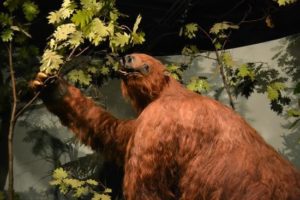Kentucky Coffeetree III: An Ecological Enigma
Most of the tree species in our native sylva either have a reciprocity agreement with animals, in which the tree provides food and shelter and the animal distributes some of its seeds, or the seed is small and lightweight, often with wings, and distributed by wind.
But Kentucky coffeetree has big, heavy seeds and no animal partner to prepare or distribute them, which likely explains its sparse distribution across its entire range, nowhere being common or abundant. Specifically, the seed pods contain a slightly toxic gel and no animal opens them or buries them and they just lie on the ground until they rot. The seeds have a hard impermeable coat and the embryos have no animal assistant to free them before they die. (In the nursery industry, the seeds are soaked in concentrated battery acid for hours to corrode the seed coat enough to make it permeable to oxygen and water, to get the embryo started.)
Permit me to offer my hypothesis to explain this ecosystem anomaly. Some chemistry background is needed first:
Alkaloids are organic molecules produced mostly by plants, many of which react with animals’ nervous systems. In very low doses, they produce a tingle or buzz or hallucinations, which our species finds invigorating, or a desirable replacement for reality. It’s thus the reason many indulge in caffeine, theobromine, nicotine, and cocaine. Low doses are usually recoverable, higher doses create brain damage – plus death if some important function like heartbeat goes on vacation.
From a plant’s perspective, they can tolerate a certain amount of grazing/browsing without serious harm, and small amounts of alkaloids don’t necessarily discourage their predator. But larger plant losses can be fatal to their predator, either by direct poisoning, or by the animal becoming careless or indifferent or clumsy while under the influence. If you watch deer feed when there are choices, they wander slowly through field and forest, taking bites of everything available, and avoiding an overdose of any one species of plant.
Plant response to predation is not just about alkaloids. Their arsenal is immense. For example, hundreds of species concentrate amygdalin in their leaves and/or seeds, including apples, peaches, pears, cherries, and plums. When this molecule encounters the stomach acids of mammals, it breaks down to release cyanide, a powerful poison. The message is clear – enjoy the fruit, don’t damage my seeds or leaves. But some animals have evolved countermeasures. For example, most mice can make a meal of apple seeds without any side effects.
So on one hand plants offer treats to those who will carry off their fruits and spread their seeds – delightful odors, tasty flavors, sweet sugars, nutritious proteins and high calorie fats. But at the same time they offer nasty deterrents to those who would damage their seeds and leaves. They are the master chemists.
So how did Kentucky coffeetree fail its chemistry lessons, and how does it even survive today, much less be widespread?
I think an important clue comes from Africa, where a legume cousin, the acacia, also has hard bean seeds in a sorta sweet pod. Elephants eat the pods and poop the seeds, and the seed coats have been corroded by stomach acids to become permeable. Studies show that most acacia trees get started in a pile of elephant poop.

Rusty the giant sloth lives in MacBride Museum, built from fossil evidence – visit him.
We, here in North America, used to have mammoths, mastodons, glyptodonts, and giant sloths, all capable of harvesting Kentucky coffeetree seeds, and one or more may have developed an immunity to the lightweight toxins and prepared the seed for “planting.” The toxins also protected the seed from being chewed up by mice and squirrels, which is still in effect today, and deters deer who do not offer a long enough residence time for stomach acids to be effective, nor subsequent planting in a big steaming pile of compost. The toxin thus reserves the seed for a large animal who can process it and plant it properly. The toxin is likely an alkaloid called cytisine and the big critters, now extinct, might have even been addicted to it, the way many people are to caffeine, theobromine, nicotine, and cocaine.
So I suggest that since the megafauna extinction, the Kentucky coffeetree has been hanging on without its animal vectors for the last 12,000 or so years to prepare and spread its seed. Its widespread distribution today may be a fossil distribution, now in the hands of, not the stomach of, a mobile primate.
For other aspects of the Kentucky coffeetree story, visit: Kentucky Coffeetree I: A Rare Species and Kentucky Coffeetree II: The Coffee.


